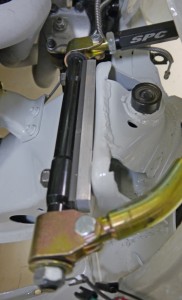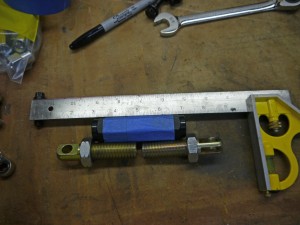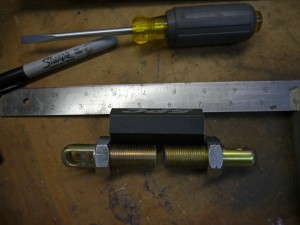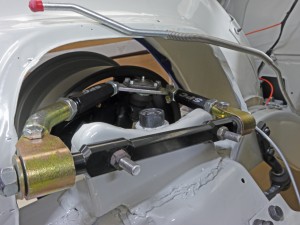Playing with the front suspension
While I should have spent the day doing something awful like bending fuel lines or polishing up ancient vent window trim, instead spent it looking at the front suspension.
The car is now sitting on the suspension, with jackstands under the front control arms and rear axle. Trying to get the bushings and springs to settle a bit, and get an idea of how much they’ll compress under the car’s weight.
Front spring perches are at a height placing the car where I believe its static ride height will be once it’s on the ground. It has about 1.5″ until the control arm hits the frame, which out at the tire is over 2″ of bump travel. Should be plenty to handle what’s out there, assuming there aren’t any big tire rub issues that pop up first.
I put the driver’s side together with the camber (rear) portion of the adjustable upper control arms fully shortened, maximizing negative camber. The factory upper control arm had an effective length of ~9.5″. The SPC arms I’m using, when fully shortened, have an effective length of ~8.5″.
With offset bushings in the lower control arms, the SPC arm fully shortened, and the car at what I believe will be its static ride height, the front suspension showed only 2.5 degrees of negative camber! That might sound like a lot for those accustomed to primarily street cars, where anything more than -1 is oddball. But for a racer, -2.5 in front is just about the minimum on anything – it might just barely be enough if you have fantastic camber curves, no body roll, and tires that are accommodating of modest camber settings. But everybody else at the autocross uses more if they can get it, and in the case of catastrophically bad geometry and lots of weight on a floppy 265 street tire, I will need tons more.
Good news is there are a couple options. The factory describes using shims at the upper control arm mounting point, to add camber and/or caster. I have a bunch of 1/8″ shims on hand, but then decided to make my own out of aluminum stock:
The silver material is 1/2″ thick, the darker stuff, 1/4″. 3/4″ is about as far as you can safely go with the factory UCA fasteners.
In building the shims and measuring how they affected camber, I found that for each 1/8″ of shim, the car would gain about 1/2 a degree of negative camber. Those values should be handy for any of the guys running stock-height spindles and factory pickup points.
So together those two shims added 6/8ths, or 3 degrees negative, taking it to a static 5.5 degrees negative camber.
That number sounds really too far out there, and I certainly hope to find that’s the case. At this ride height, the outer pivot point of the upper control arm appears parallel, or perhaps just slightly above, the inner pivot point. This is a good thing, meaning the UCA will be pulling the top of the spindle “in”, in a manner that should produce favorable negative camber gain. However the lower control arm is definitely past parallel, with the lower ball joint a little bit above the inner pivot point. This means the suspension is also pulling in the lower part of the spindle, a camber-robbing direction.
One helpful element, is the lower control arm is effectively ~16″ long, whereas our SPC full-short arm is only ~8.5″. The smaller radius of the upper arm should product lateral (inward) movement more quickly compared to the lower arm, hopefully passing it somepoint soon, and generating some negative camber gain. One could do something like the Guldstrand Mod – it lowers the mounting point for the upper control arm, putting it in a steeper part of its travel, generating more camber gain. Unfortunately relocating pickup points is not only illegal in ST, it’s illegal in most forms of motorsport – at least those that don’t also allow for a complete tube frame chassis.
Since the upper control arm is in a beneficial part of its travel at this ride height (which I believe is just about on the bump stop in a stock car) – there may be a better way than shims. What if one could shorter the upper arm even more?
The turnbuckle for camber adjustment on the SPC arm is 4″ long as delievered from the supplier. SPC does not appear to make a shorter turnbuckle-
So I made one, by cutting down each end of the turnbuckle by 1/2″, and cutting down the threaded inserts by an equivalent amount. The result-
With the turnbuckle now 3″ in length, the upper control arm can be shortened to 7.5″ in length, less than half the length of the lower control arm. Here it is on the car:
No clearance issues anywhere I could see, fits fine even at full short. An added benefit I was noticing with the negative camber, is the lower ball joint appeared to sit at a more natural angle. The lower control arm has a bit of a tilt to it, and with the stock upper control arm at this ride height, the car would normally have its camber about eight degrees more positive than this, equating to an extra eight degree of tilt to an already outward-tilted ball joint.
Still, not sure I will need this much. Won’t know for sure until some testing and tuning is done. I ran about -4.5 degrees on my strut-suspended 240sx, but it had a very compromised suspension at the ride heights I used, only losing camber in bump. I’ll have to do some more measurements with the springs out, but there’s a chance with this upper arm, the car is at least not losing any camber.
As stated elsewhere in this blog, I’m a big believer in providing yourself with a wide range of adjustability. You don’t ever want to be at the extreme of any of your self-defined adjustment ranges, for what if “more” in a given tuning direction, was better? In this case with no shims and the upper arms full short, the car has a ”
“natural” negative camber setting of over six degrees (which I have seen people use on tracked E36 BMW race cars). By lengthening the upper arm, camber could be brought to zero, and with shims, could go even further negative, to up past 10 degrees, which I couldn’t ever see needing. There’s also the possibility, if the short arm length causes issues, where it could be lengthened, in concert with shims, to maintain the same static value, but change the dynamic geometry to something less aggressive in camber gain.
Hopefully this is enough to begin to tame the Camaro’s front suspension demons!




Leave a Reply
You must be logged in to post a comment.